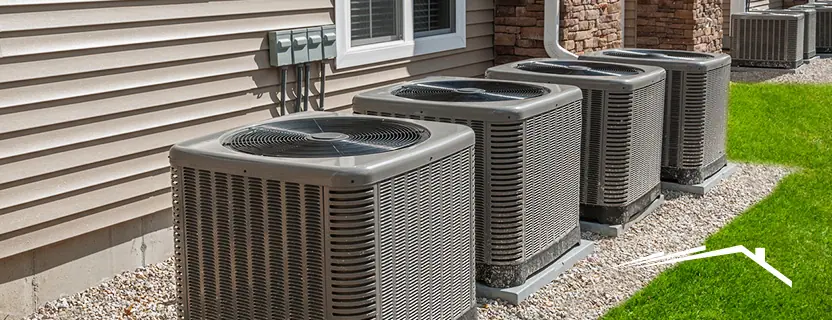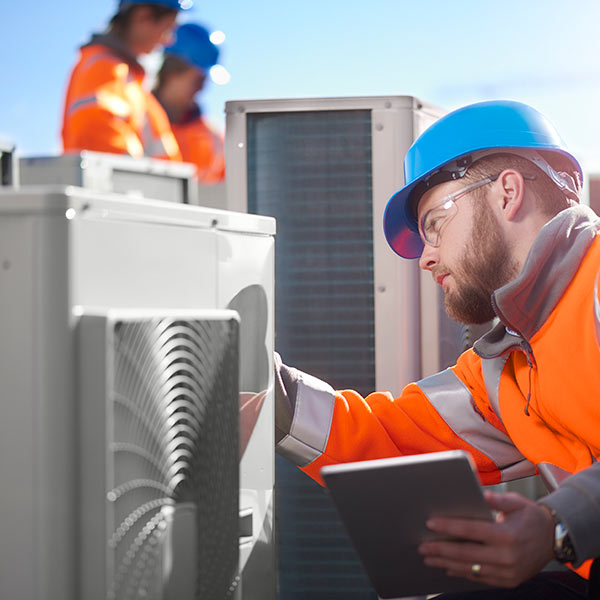Just How a Warm Pump and Heating System Collaborate to Optimize Your Home's Home heating Effectiveness
Understanding how a warm pump and heater collaborate is important for property owners seeking reliable home heating options. Each system has its staminas, giving a well balanced method to home convenience. The heat pump stands out in modest temperatures, while the heating system supplies rapid warmth during extreme cold. This synergy not only reduces energy costs but additionally enhances the life expectancy of both home appliances. What elements affect this collaboration, and just how can property owners optimize their advantages?
Recognizing Warmth Pumps: How They Work
Numerous people might be strange with their inner workings, warmth pumps play an essential role in modern-day home heating systems. These tools operate by transferring warmth from one area to one more, using the concepts of thermodynamics. In cooler months, a heat pump removes warmth from the outside air, ground, or water, and transfers it inside to warm the living room. Alternatively, throughout warmer months, it can turn around the procedure, functioning as an ac unit by removing heat from inside to the outside.Heat pumps contain an evaporator, condenser, development, and compressor shutoff. The cooling agent within the system absorbs warm as it vaporizes at reduced temperature levels and pressures. The compressor then boosts the stress and temperature level of the cooling agent, enabling it to release warm as it condenses. This reliable process can greatly reduce energy usage compared to conventional heating approaches, making heat pumps a sustainable option for environment control in homes.
The Role of Heating Systems in Home Home Heating
Heaters play an important duty in home heating by giving a trustworthy resource of heat during the colder months. They run by generating warmth via burning or electric resistance, distributing it throughout the home via ducts or glowing systems. The efficiency of a heating system is usually determined by its Yearly Fuel Usage Performance (AFUE) ranking, which suggests exactly how properly the system converts fuel right into heat.Furnaces can make use of different power sources, consisting of all-natural gas, power, lp, or oil, enabling property owners to choose the most suitable choice for their demands. Unlike warm pumps, which might struggle in extreme chilly, furnaces keep consistent performance, guaranteeing that indoor temperature levels continue to be comfortable no matter of exterior conditions. In addition, contemporary heaters typically come outfitted with innovative modern technology, such as wise thermostats and variable-speed blowers, enhancing their efficiency and responsiveness. This convenience makes furnaces a crucial element in comprehensive home heating strategies.

Advantages of Using Both Solutions Together
Integrating the strengths of both heaters and heatpump can bring about an extra effective and effective home heating service. Utilizing both systems allows property owners to benefit from the heatpump's energy effectiveness during milder temperatures while counting on the heating system for more extreme cold problems. This twin strategy can significantly decrease energy expenses, as warmth pumps consume less power than standard heating approaches when temperature levels are moderate.Additionally, utilizing both systems together can boost convenience levels in the home. Heatpump can supply constant, even heating, while heating systems can quickly raise ambient temperature levels when required. The integration of both systems can expand the life-span of tools by lowering wear and tear on each system, as they share the work. Inevitably, home owners can delight in a well balanced, affordable home heating remedy that readjusts effortlessly to differing weather problems, guaranteeing a warm and welcoming home throughout the cold weather.
How Heat Pumps and Furnaces Enhance Each Other
They produce a complementary heating system that makes best use of effectiveness and comfort when homeowners integrate warm pumps and heaters. Heatpump operate by transferring warm from the outdoors air or ground, making them extremely reliable in modest climates. They excel throughout milder temperatures, offering economical home heating. Alternatively, heating systems generate warm through burning or electrical resistance, supplying solid, prompt warmth throughout extreme cold conditions.The combination of these 2 systems permits dynamic modifications based upon temperature level fluctuations. Throughout warmer months or milder winter months days, the heat pump can take the lead, preserving power and reducing costs. As temperature levels drop, the heater can effortlessly involve, guaranteeing regular heat throughout the home. This synergy not just maximizes power usage however additionally boosts the life-span of both systems, as each system operates within its optimal performance variety. With each other, they develop a balanced environment that adapts to differing environment needs.
Maximizing Efficiency: Tips for Homeowners
Property owners can enhance their home heating efficiency with numerous practical strategies. Establishing a normal upkeep timetable, integrating smart thermostat technology, and implementing reliable insulation and securing remedies are crucial steps. These measures not only enhance comfort however likewise reduce energy expenses.
Normal Maintenance Schedule
To ensure maximum heating efficiency, developing a normal upkeep schedule is important for any type of home. House owners must focus on regular examinations of both heatpump and heating systems to identify peak efficiency. This includes changing air filters every one to three months, as clogged up filters can considerably minimize performance. In addition, organizing expert upkeep at the very least yearly permits specialists to identify and resolve prospective concerns prior to they intensify. Property owners need to likewise cleanse the heatpump's outside unit to protect against debris accumulation that can impede air movement. By adhering to a routine maintenance timetable, property owners not only enhance their heater' effectiveness yet also prolong their life-span, leading to higher comfort and decreased power expenses throughout the cooler months.
Smart Thermostat Combination
Incorporating a clever thermostat right into a home heating system can considerably improve energy efficiency, particularly as it enables for specific control over temperature level settings. These gadgets can find out the property owner's routine and preferences, automatically readjusting the temperature level to optimize comfort while decreasing power usage. They can reduce home heating throughout times when the home is empty, decreasing unneeded intake. Several wise thermostats also supply real-time energy use data, enabling property owners to make enlightened choices about their heating habits. In addition, remote access through smart device applications permits users to adjust settings from anywhere, ensuring the home is cozy upon return. On the whole, clever thermostat assimilation not just improves convenience but considerably adds to power financial savings and performance.
Insulation and Sealing Solutions
Smart thermostats play an essential duty in power performance, however their effectiveness can be considerably improved by correct insulation and securing services. House owners should prioritize protecting walls, attic rooms, and floors to minimize warm loss. High-quality insulation materials, such as spray foam or fiberglass, can considerably improve thermal resistance. Furthermore, securing spaces around home windows, doors, and air ducts stops cool air seepage and warmth retreat. Weatherstripping and caulking are reliable approaches for resolving these leakages - ductless mini splits. Regular evaluations for air leakages, in addition to the usage of blower door examinations, can aid recognize issue locations. By investing in insulation and sealing, property owners can maximize the performance of their heating unit, inevitably resulting in lowered power consumption and reduced energy costs
Usual Misconceptions About Heat Pumps and Furnaces
What false impressions surround warm pumps and heaters? Several people mistakenly believe that warm pumps are inadequate in chillier climates. Actually, modern warmth pumps are developed to operate effectively also in low temperature levels, offering trustworthy heating throughout winter season. One more typical misconception is that furnaces are always a lot more efficient than heat pumps. Nevertheless, this depends on the specific power resources and efficiency ratings of the units concerned. Some might likewise believe that making use of both systems all at once is unnecessary, however actually, this mix can enhance heating effectiveness, particularly during extreme climate condition. Additionally, people frequently assume that heatpump require consistent upkeep, when actually, they have comparable maintenance requires to typical heater. By unmasking these myths, home owners can make even more educated decisions regarding their home heating options, ultimately bring about boosted convenience and power effectiveness in their homes.
Upkeep Considerations for Combined Equipments

Regularly Asked Questions
Can Warm Pumps Work Successfully in Exceptionally Cold Climates?
Warmth pumps can have a hard time in very more info here cold environments as a result of reduced performance and warm extraction restrictions. However, innovations in innovation have caused models made for far better efficiency in such problems, improving their feasibility in extreme environments.
Just How Lengthy Do Heat Pumps and Furnaces Normally Last?
Heatpump generally last 15 to twenty years, while heating systems have a life expectancy of 15 to thirty years. Regular upkeep can extend their durability, ensuring reliable procedure and decreasing the demand for early substitutes.

What Is the Ordinary Price of Setting Up Both Systems?
The average cost of setting up both a heat pump and a heater typically ranges in between $5,000 to $10,000 - heat pump replacement ooltewah tn. Aspects affecting this cost consist of system size, installment intricacy, and regional labor rates
Are There Tax Incentives for Using Energy-Efficient Home Heating Systems?
Many house owners ask about tax obligation incentives for energy-efficient heater. Numerous federal and state programs commonly use debts or discounts, urging the fostering of sustainable innovations to decrease energy intake and advertise environmental responsibility.
How Do I Pick the Right Size Heatpump and Heating System?
Choosing the ideal size heat pump and heating system involves computing the home's square video footage, taking into consideration insulation high quality, and reviewing local environment. Consulting an expert can ensure perfect system performance and energy effectiveness based upon details requirements. heat pump replacement ooltewah tn. Comprehending just how a heat pump and heater job together is essential for house owners seeking reliable home heating options. In colder months, a warm pump extracts warmth from the outside air, ground, or water, and transfers it inside to warm the living room. When homeowners integrate heat pumps and heating systems, they produce a complementary heating system that optimizes effectiveness and comfort. Heat Clicking Here pumps run by moving warm content from the outside air or ground, making them highly effective in modest climates. Warmth pumps can battle in exceptionally cold environments due to lowered effectiveness and warmth extraction limitations